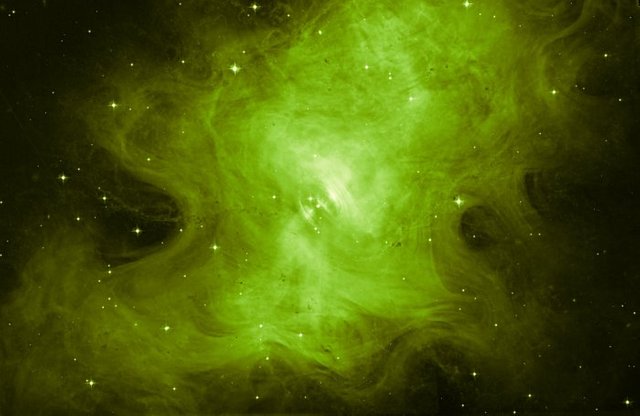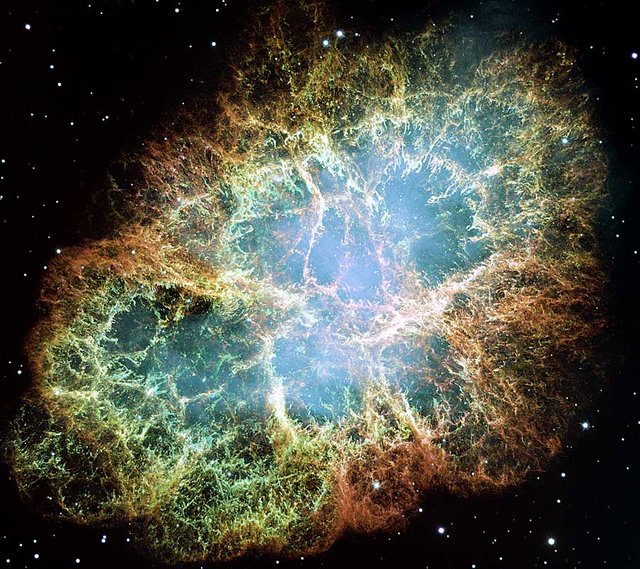"Hubble" photographed Treats "ghost" of the Crab Nebula

Crab Nebula. Source: ESA / Hubble & NASA
Orbital Observatory "Hubble" has received new photos of the famous Crab Nebula, acquired the "ghost" green by using only one filter when observing these supernova remnants, according to the Space Telescope site.
Crab Nebula - one of the most famous objects of the cosmos - is the remains of a supernova explosion, one of the first outbreaks of the kind documented by mankind. She broke out in 1054 AD, and the new star of unusual Chinese chroniclers mentioned, first described by its position, brightness and other details, which allowed astronomers to the early 20th century for the first time to link with supernovae like a fog.
This object is located at a relatively short distance from the Earth, about 6.5 thousand light-years away towards the constellation of Taurus, and today he is a giant luminous cloud of gas and dust stretched to about 11 light-years away in the explosion of a dying star. The boundaries of the Crab nebula gradually grow, increasing by 1,500 kilometers per second.
In addition to the hot clouds of gas, traces existed in the past, the star can be seen in the center of the Crab Nebula, which is a neutron star, a pulsar rotating at a speed of 30 revolutions per second. Due to its proximity to the Earth, it is the brightest radio and X-ray source in the vicinity of our space, and the pulsar is now used as a "guiding star" for almost all space-based observatories, in which scientists checked their work tools and calibrate them.
New image of the Crab Nebula derived "Hubble" with the ACS camera and a green color filter, less detailed than images obtained in previous years. On the other hand, "monochrome" image makes it easier to consider "Space Crab" and see where it starts and ends with the border.

Copyright ESA/Herschel/PACS/MESS Key Programme Supernova Remnant Team; NASA, ESA and Allison Loll/Jeff Hester (Arizona State University)
The Crab Nebula (M 1, of NGC 1952, Taurus A) - gaseous nebula in the constellation Taurus, is a remnant of the supernova SN 1054 and plerions [3].
Nebula first observed by John Bevis in 1731. It was the first astronomical object identified as the historical supernova explosion recorded by Chinese and Arab astronomers in 1054. Located at a distance of about 6,500 light-years (2 kpc) from Earth, the nebula has a diameter of 11 light-years (3.4 pc) and expands at a rate of about 1,500 kilometers per second.
In the center of the nebula is a pulsar «Crab Pulsar» (neutron star), 28-30 km in diameter, which emits pulses of radiation from gamma rays to radio waves. The X-ray and gamma-ray radiation more than 30 keV, this pulsar is the strongest permanent source of such radiation in our galaxy.
The nebula acts as a source of radiation for studying celestial bodies that overshadow it. In the 1950s and 1960s, radiation was observed through the solar corona at supercorona study in 2003 measured the thickness of the atmosphere of Saturn's moon - Titan by the way he blocked the x-rays from the nebula.:"

Image Credit: NASA
At least needs a source for the directly quoted material :)
And possibly for the story. It is always easier for people who want to know more about it if there is something to click on. In addition, citing his/her sources is a matter of being fair with respect to the original author one has read about :)
I'm sorry, did not understand what to do?
Just indicating where you found the information you based your post on :)
well, to be made
need a reference from which the quote?
If you've translated this from another article, please instead only post a small amount of text and then link to the article. Not crediting the author is plagiarism, and copying too much of an article is copyright infringement.
thank you very much, I understand where the mistake, fix it later ;)